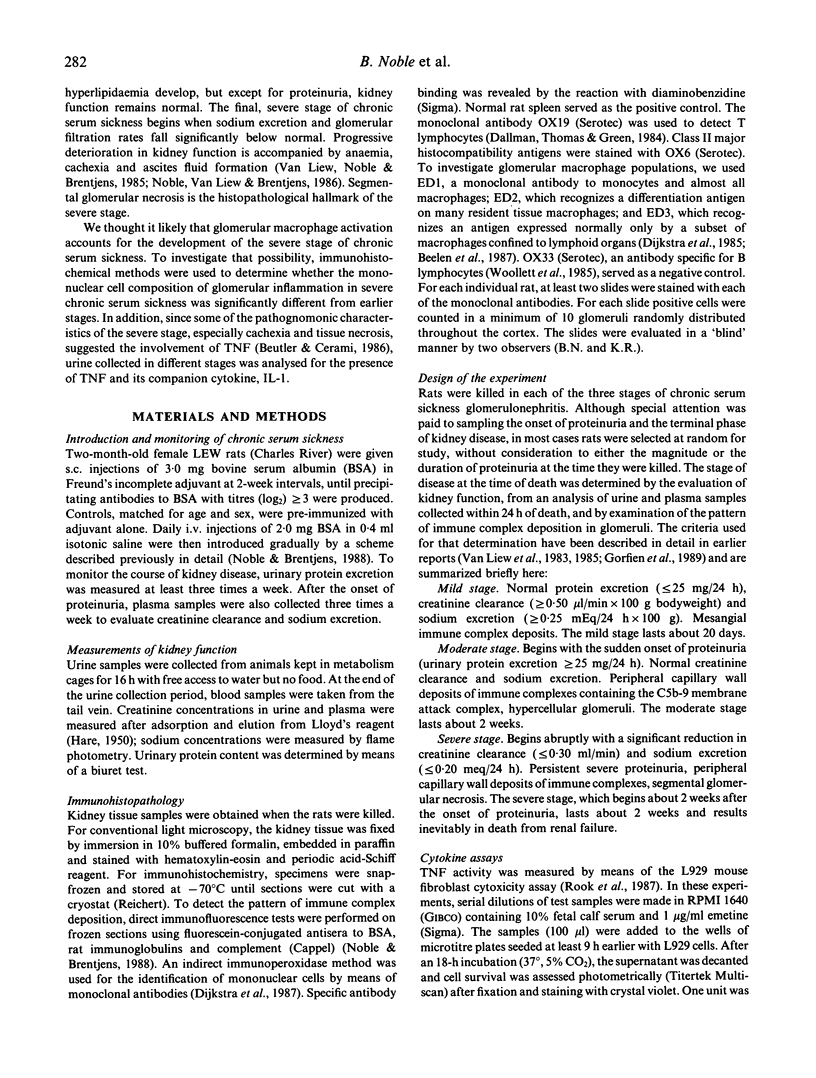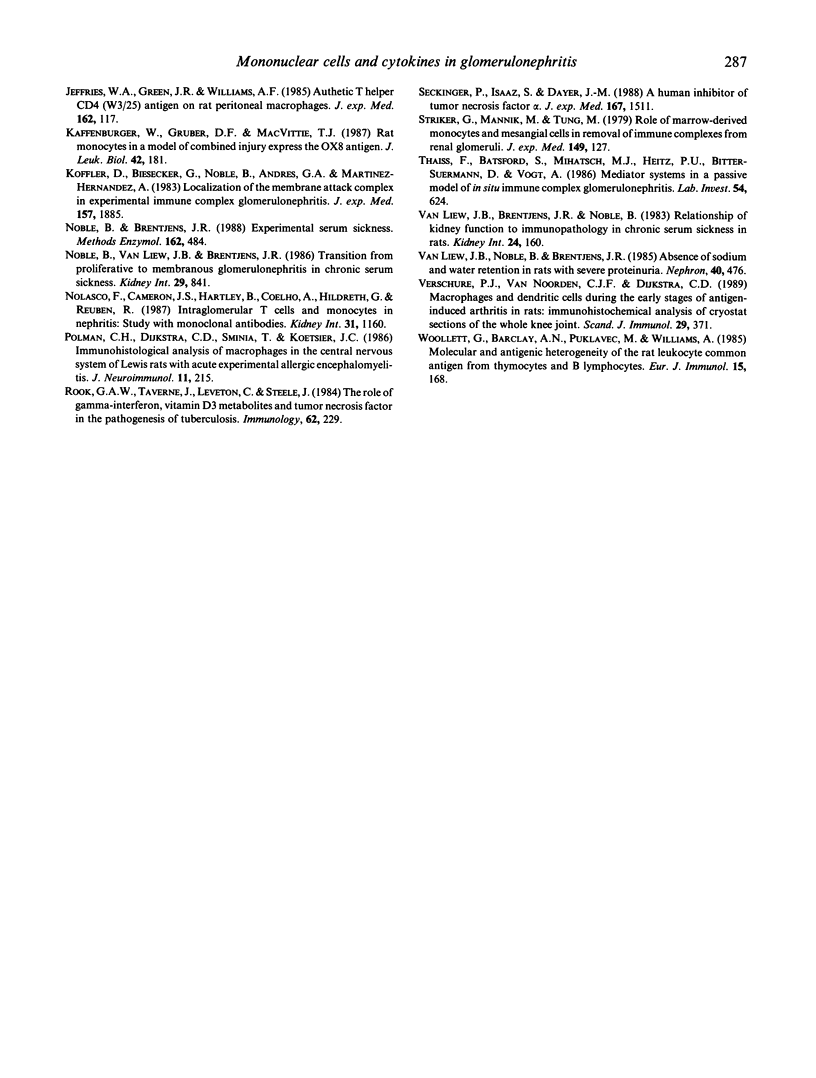Abstract
Immunohistochemical methods were used to investigate the role of macrophages in the progression of proliferative immune complex glomerulonephritis. The mononuclear cell component of glomerular inflammation was analysed in three different stages of chronic serum sickness, each of which was clearly distinguished by criteria of kidney function. Urinary excretion of the macrophage secretory products interleukin-1 and tumour necrosis factor was also evaluated in relation to the functional severity of kidney disease. T lymphocytes and macrophages began to accumulate in glomeruli at the onset of proteinuria, but not before. Urinary excretion of interleukin-1 also began with proteinuria. Proteinuria increased in direct correlation with increases in the number of glomerular macrophages. Development of the most severe stage of glomerulonephritis, characterized by cachexia, declining kidney function, and necrotizing glomerular pathology, was accompanied by the disappearance of T cells from glomeruli and the expression of highly abnormal phenotypes by most macrophages. In addition, there was a switch from urinary excretion of interleukin-1 to excretion of tumour necrosis factor. The progression of proliferative immune complex glomerulonephritis was associated with qualitative as well as quantitative changes in glomerular macrophage populations. Differentiation and/or activation of those glomerular macrophages may have resulted from local T cell-mediated immunoregulation. Measurements of urinary cytokine excretion provided a reliable means of monitoring disease progression. The local action of tumour necrosis factor probably contributed to declining kidney function in the most severe stage of disease.
Full text
PDF






Images in this article
Selected References
These references are in PubMed. This may not be the complete list of references from this article.
- Barclay A. N. The localization of populations of lymphocytes defined by monoclonal antibodies in rat lymphoid tissues. Immunology. 1981 Apr;42(4):593–600. [PMC free article] [PubMed] [Google Scholar]
- Becker G. J., Hancock W. W., Stow J. L., Glasgow E. F., Atkins R. C., Thomson N. M. Involvement of the macrophage in experimental chronic immune complex glomerulonephritis. Nephron. 1982;32(3):227–233. doi: 10.1159/000182850. [DOI] [PubMed] [Google Scholar]
- Beutler B., Cerami A. Cachectin and tumour necrosis factor as two sides of the same biological coin. Nature. 1986 Apr 17;320(6063):584–588. doi: 10.1038/320584a0. [DOI] [PubMed] [Google Scholar]
- Bhan A. K., Collins A. B., Schneeberger E. E., McCluskey R. T. A cell-mediated reaction against glomerular-bound immune complexes. J Exp Med. 1979 Dec 1;150(6):1410–1420. doi: 10.1084/jem.150.6.1410. [DOI] [PMC free article] [PubMed] [Google Scholar]
- Boswell J. M., Yui M. A., Burt D. W., Kelley V. E. Increased tumor necrosis factor and IL-1 beta gene expression in the kidneys of mice with lupus nephritis. J Immunol. 1988 Nov 1;141(9):3050–3054. [PubMed] [Google Scholar]
- Brideau R. J., Carter P. B., McMaster W. R., Mason D. W., Williams A. F. Two subsets of rat T lymphocytes defined with monoclonal antibodies. Eur J Immunol. 1980 Aug;10(8):609–615. doi: 10.1002/eji.1830100807. [DOI] [PubMed] [Google Scholar]
- Dallman M. J., Thomas M. L., Green J. R. MRC OX-19: a monoclonal antibody that labels rat T lymphocytes and augments in vitro proliferative responses. Eur J Immunol. 1984 Mar;14(3):260–267. doi: 10.1002/eji.1830140311. [DOI] [PubMed] [Google Scholar]
- Debets J. M., van der Linden C. J., Spronken I. E., Buurman W. A. T cell-mediated production of tumour necrosis factor-alpha by monocytes. Scand J Immunol. 1988 May;27(5):601–608. doi: 10.1111/j.1365-3083.1988.tb02388.x. [DOI] [PubMed] [Google Scholar]
- Dijkstra C. D., Döpp E. A., Joling P., Kraal G. The heterogeneity of mononuclear phagocytes in lymphoid organs: distinct macrophage subpopulations in the rat recognized by monoclonal antibodies ED1, ED2 and ED3. Immunology. 1985 Mar;54(3):589–599. [PMC free article] [PubMed] [Google Scholar]
- Dijkstra C. D., Döpp E. A., Vogels I. M., Van Noorden C. J. Macrophages and dendritic cells in antigen-induced arthritis. An immunohistochemical study using cryostat sections of the whole knee joint of rat. Scand J Immunol. 1987 Nov;26(5):513–523. doi: 10.1111/j.1365-3083.1987.tb02285.x. [DOI] [PubMed] [Google Scholar]
- HARE R. S. Endogenous creatinine in serum and urine. Proc Soc Exp Biol Med. 1950 May;74(1):148–151. doi: 10.3181/00379727-74-17837. [DOI] [PubMed] [Google Scholar]
- Holdsworth S. R. Fc dependence of macrophage accumulation and subsequent injury in experimental glomerulonephritis. J Immunol. 1983 Feb;130(2):735–739. [PubMed] [Google Scholar]
- Holdsworth S. R., Neale T. J., Wilson C. B. The participation of macrophages and monocytes in experimental immune complex glomerulonephritis. Clin Immunol Immunopathol. 1980 Mar;15(3):510–524. doi: 10.1016/0090-1229(80)90063-x. [DOI] [PubMed] [Google Scholar]
- Hooke D. H., Hancock W. W., Gee D. C., Kraft N., Atkins R. C. Monoclonal antibody analysis of glomerular hypercellularity in human glomerulonephritis. Clin Nephrol. 1984 Oct;22(4):163–168. [PubMed] [Google Scholar]
- Jefferies W. A., Green J. R., Williams A. F. Authentic T helper CD4 (W3/25) antigen on rat peritoneal macrophages. J Exp Med. 1985 Jul 1;162(1):117–127. doi: 10.1084/jem.162.1.117. [DOI] [PMC free article] [PubMed] [Google Scholar]
- Kaffenberger W., Gruber D. F., MacVittie T. J. Rat monocytes in a model of combined injury express the OX8 antigen. J Leukoc Biol. 1987 Sep;42(3):181–187. doi: 10.1002/jlb.42.3.181. [DOI] [PubMed] [Google Scholar]
- Koffler D., Biesecker G., Noble B., Andres G. A., Martinez-Hernandez A. Localization of the membrane attack complex (MAC) in experimental immune complex glomerulonephritis. J Exp Med. 1983 Jun 1;157(6):1885–1905. doi: 10.1084/jem.157.6.1885. [DOI] [PMC free article] [PubMed] [Google Scholar]
- Noble B., Brentjens J. R. Experimental serum sickness. Methods Enzymol. 1988;162:484–501. doi: 10.1016/0076-6879(88)62099-4. [DOI] [PubMed] [Google Scholar]
- Noble B., Van Liew J. B., Brentjens J. R. A transition from proliferative to membranous glomerulonephritis in chronic serum sickness. Kidney Int. 1986 Apr;29(4):841–848. doi: 10.1038/ki.1986.75. [DOI] [PubMed] [Google Scholar]
- Nolasco F. E., Cameron J. S., Hartley B., Coelho A., Hildreth G., Reuben R. Intraglomerular T cells and monocytes in nephritis: study with monoclonal antibodies. Kidney Int. 1987 May;31(5):1160–1166. doi: 10.1038/ki.1987.123. [DOI] [PubMed] [Google Scholar]
- Polman C. H., Dijkstra C. D., Sminia T., Koetsier J. C. Immunohistological analysis of macrophages in the central nervous system of Lewis rats with acute experimental allergic encephalomyelitis. J Neuroimmunol. 1986 May;11(3):215–222. doi: 10.1016/0165-5728(86)90005-6. [DOI] [PubMed] [Google Scholar]
- Rook G. A., Taverne J., Leveton C., Steele J. The role of gamma-interferon, vitamin D3 metabolites and tumour necrosis factor in the pathogenesis of tuberculosis. Immunology. 1987 Oct;62(2):229–234. [PMC free article] [PubMed] [Google Scholar]
- Striker G. E., Mannik M., Tung M. Y. Role of marrow-derived monocytes and mesangial cells in removal of immune complexes from renal glomeruli. J Exp Med. 1979 Jan 1;149(1):127–136. doi: 10.1084/jem.149.1.127. [DOI] [PMC free article] [PubMed] [Google Scholar]
- Thaiss F., Batsford S., Mihatsch M. J., Heitz P. U., Bitter-Suermann D., Vogt A. Mediator systems in a passive model of in situ immune complex glomerulonephritis. Role for complement, polymorphonuclear granulocytes and monocytes. Lab Invest. 1986 Jun;54(6):624–635. [PubMed] [Google Scholar]
- Van Liew J. B., Brentjens J. R., Noble B. Relationship of kidney function to immunopathology in chronic serum sickness of rats. Kidney Int. 1983 Aug;24(2):160–169. doi: 10.1038/ki.1983.140. [DOI] [PubMed] [Google Scholar]
- Van Liew J. B., Noble B., Brentjens J. R. Absence of sodium and water retention in rats with severe proteinuria. Nephron. 1985;40(4):476–481. doi: 10.1159/000183524. [DOI] [PubMed] [Google Scholar]
- Verschure P. J., Van Noorden C. J., Dijkstra C. D. Macrophages and dendritic cells during the early stages of antigen-induced arthritis in rats: immunohistochemical analysis of cryostat sections of the whole knee joint. Scand J Immunol. 1989 Mar;29(3):371–381. doi: 10.1111/j.1365-3083.1989.tb01136.x. [DOI] [PubMed] [Google Scholar]
- Woollett G. R., Barclay A. N., Puklavec M., Williams A. F. Molecular and antigenic heterogeneity of the rat leukocyte-common antigen from thymocytes and T and B lymphocytes. Eur J Immunol. 1985 Feb;15(2):168–173. doi: 10.1002/eji.1830150211. [DOI] [PubMed] [Google Scholar]



